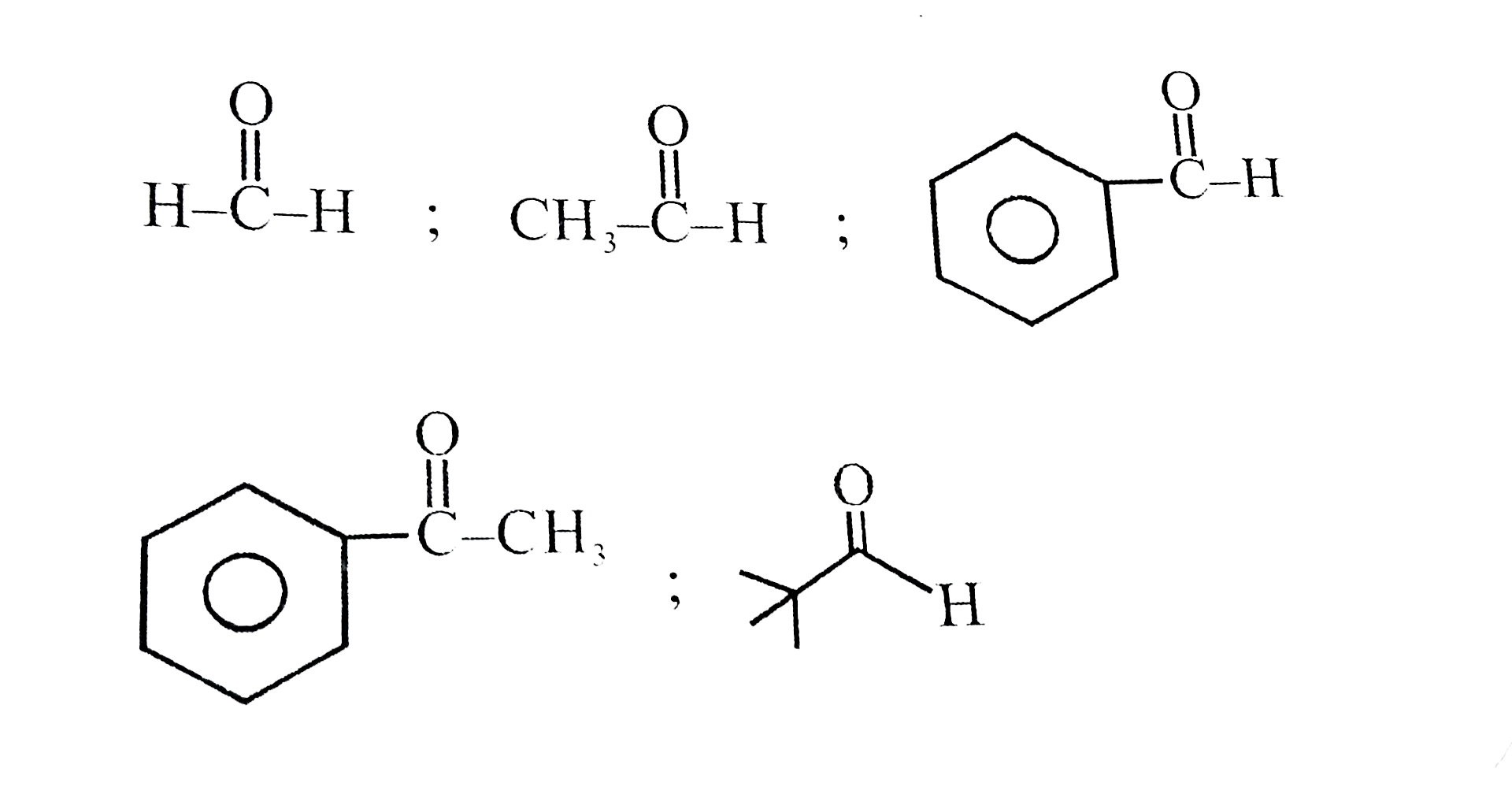Describe the following
i. Acetylation
ii. Cannizzaro reaction
iii. Cross aldol condensation
iv. Decarboxylation
Step-by-Step Text Solution
i. Acetylation
Acetylation is a chemical reaction that introduces an acetyl group (−COCH₃) into a compound. This reaction is typically carried out using reagents such as acetyl chloride (CH₃COCl) or acetic anhydride ((CH₃CO)₂O).
Example Reaction:
When ethanol (C₂H₅OH) is treated with acetyl chloride in the presence of a base like pyridine, the acetyl group is introduced to the ethanol, resulting in the formation of ethyl acetate (C₂H₅OCOCH₃) and hydrochloric acid (HCl) as a byproduct.
Reaction:
C2H5OH+CH3COClpyridine−−−−−→C2H5OCOCH3+HCl
ii. Cannizzaro Reaction
The Cannizzaro reaction is a redox reaction that occurs in aldehydes that do not have an alpha hydrogen atom. In this reaction, one molecule of the aldehyde is oxidized to a carboxylic acid, while another molecule is reduced to an alcohol.
Example Reaction:
For example, when formaldehyde (HCHO) is treated with concentrated potassium hydroxide (KOH), one molecule is oxidized to formic acid (HCOOH), and another is reduced to methanol (CH₃OH).
Reaction:
2HCHO+KOH→HCOOK+CH3OH
iii. Cross Aldol Condensation
Cross aldol condensation is a reaction between two different aldehydes or ketones that contain alpha hydrogen atoms. In this reaction, one compound acts as the nucleophile and the other as the electrophile, leading to the formation of a β-hydroxy aldehyde or ketone, which can further dehydrate to form an α,β-unsaturated carbonyl compound.
Example Reaction:
For instance, when acetaldehyde (CH₃CHO) reacts with butyraldehyde (C₃H₇CHO), the products formed can be 3-hydroxybutanal, which can then dehydrate to form crotonaldehyde (CH₃CH=CHCHO).
Reaction:
CH3CHO+C3H7CHO→C4H8O (β-hydroxy aldehyde)→C4H6O (α,β-unsaturated aldehyde)
iv. Decarboxylation
Decarboxylation is the process of removing a carboxyl group (−COOH) from a compound, resulting in the release of carbon dioxide (CO₂). This reaction often involves the use of soda lime (a mixture of sodium hydroxide and calcium oxide) as a reagent.
Example Reaction:
For example, when sodium acetate (CH₃COONa) is heated with soda lime, it undergoes decarboxylation to produce methane (CH₄) and sodium carbonate (Na₂CO₃).
Reaction:
CH3COONa+NaOHCaO−−→CH4+Na2CO3
Acetylation is a chemical reaction that introduces an acetyl group (−COCH₃) into a compound. This reaction is typically carried out using reagents such as acetyl chloride (CH₃COCl) or acetic anhydride ((CH₃CO)₂O).
When ethanol (C₂H₅OH) is treated with acetyl chloride in the presence of a base like pyridine, the acetyl group is introduced to the ethanol, resulting in the formation of ethyl acetate (C₂H₅OCOCH₃) and hydrochloric acid (HCl) as a byproduct.
C2H5OH+CH3COClpyridine−−−−−→C2H5OCOCH3+HCl
The Cannizzaro reaction is a redox reaction that occurs in aldehydes that do not have an alpha hydrogen atom. In this reaction, one molecule of the aldehyde is oxidized to a carboxylic acid, while another molecule is reduced to an alcohol.
For example, when formaldehyde (HCHO) is treated with concentrated potassium hydroxide (KOH), one molecule is oxidized to formic acid (HCOOH), and another is reduced to methanol (CH₃OH).
2HCHO+KOH→HCOOK+CH3OH
Cross aldol condensation is a reaction between two different aldehydes or ketones that contain alpha hydrogen atoms. In this reaction, one compound acts as the nucleophile and the other as the electrophile, leading to the formation of a β-hydroxy aldehyde or ketone, which can further dehydrate to form an α,β-unsaturated carbonyl compound.
For instance, when acetaldehyde (CH₃CHO) reacts with butyraldehyde (C₃H₇CHO), the products formed can be 3-hydroxybutanal, which can then dehydrate to form crotonaldehyde (CH₃CH=CHCHO).
CH3CHO+C3H7CHO→C4H8O (β-hydroxy aldehyde)→C4H6O (α,β-unsaturated aldehyde)
Decarboxylation is the process of removing a carboxyl group (−COOH) from a compound, resulting in the release of carbon dioxide (CO₂). This reaction often involves the use of soda lime (a mixture of sodium hydroxide and calcium oxide) as a reagent.
For example, when sodium acetate (CH₃COONa) is heated with soda lime, it undergoes decarboxylation to produce methane (CH₄) and sodium carbonate (Na₂CO₃).
CH3COONa+NaOHCaO−−→CH4+Na2CO3
Topper's Solved these Questions
- ALDEHYDES, KETONES AND CARBOXYLIC ACIDSBook:NCERT ENGLISHChapter:ALDEHYDES, KETONES AND CARBOXYLIC ACIDSExercise:Exercise
Explore 28 Videos
- ALCOHOLS, PHENOLS AND ETHERSBook:NCERT ENGLISHChapter:ALCOHOLS, PHENOLS AND ETHERSExercise:EXERCISE
Explore 45 Videos
- AMINESBook:NCERT ENGLISHChapter:AMINESExercise:Exercise
Explore 23 Videos
Similar Questions
Describe aldol condensation.
View SolutionDescribe aldol condensation.
View Solution(a) Illustrate the following reactions giving a suitable example for each.
(i) Cross aldol condensation
(ii) Decarboxylation
(b) Give simple tests to distinguish between the following pairs of compound
(i) Pentan-2-one and pentan-3-one
(ii) Benzaldehyde and Acetophenone
(ii) Phenol and Benzoic acid
View SolutionGive Examples of the following:
Crossed-Cannizzaro reaction
View SolutionHow many compounds gives Cannizzaro reaction and aldol condensation respectively

View SolutionComplete the following reaction : i.

ii.
iii.
iv.
View SolutionAccount for the following :
(i) CH3CHO is more reactive than CH3COCH3 towards reaction with HCN.
(ii) Carboxylic acid is a stronger acid then phenol .
(b) Wrtie the chemical equations to illuustrate the following reaction :
(i) Wolff-Kishner reduction
(ii) Aldol condensation
(iii) Cannizzaro reaction
View SolutionExplain the following reactions :
Aldol condensation
View SolutionWrite chemical equations to illustrate the following name bearing reactions: (i) Cannizzaro 's reaction
(ii) Hell - Volhard -Zelinsky reaction
View SolutionGive a brief account of the following reaction:
Cross-Aldol condensation
View Solution
